HOME | ABOUT US | MEDIA KIT | CONTACT US | INQUIRE
HOME | ABOUT US | MEDIA KIT | CONTACT US | INQUIRE

To get a sense of how far women have come within the executive ranks of America’s construction and design companies, one would need to look no further than the fifth-floor conference room at Lockton on Nov. 15. There, two dozen executives gathered for a truly unique event:
The first-ever Women in Construction and Design Industry Outlook Assembly. Featuring a cast of power players from engineering, architecture and related construction industry sectors, the assembly was co-chaired by Teresa Martin and Claudia Mandato of Lockton, the sponsoring company. For several hours, they took the measure of the road traveled to progress for women and their careers in a sector long dominated by men in both the rank-and-file and the C-suite. Their take-away: Much has been achieved, but much more progress remains the mission.
On the way to that conclusion, they explored challenges of finding the right talent, the gargantuan task of retaining that hard-won talent,
benefits, compensation, working environment, family considerations, safety issues, and more. It’s hard to imagine a man in any construction role, blue collar or white, being able to read about their discussion without learning something new about the dynamics of gender within this vital economic sector.
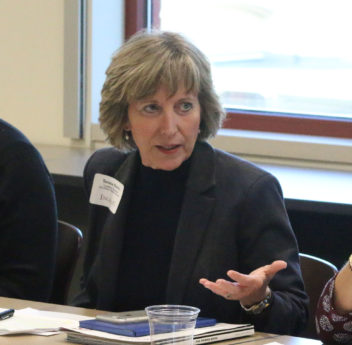
Teresa Martin opened the session with a discussion on the role of corporate culture.
It Starts With Culture
A pair of personal experiences brought into vivid relief the depth of change in construction over the past 20 to 30 years—and some of the distance yet to be traveled.
Joyce Farris shared one of those. Today, she sees construction through a financial lens at CBIZ/MHM as managing director in the construction group. “When I started in 1983, I was one of only five women out of 80 people in the office, and when I started in the construction area in 1985,
I was the only female,” she said.
There were times, Farris said, when she was the only woman in a room of 150 men at a trade meeting, but “now, I can go to Association of General Contractors meetings and we’re everywhere.” And that is a success shared by all at the table who had made it a mission to promote the interests of women in their workplaces, she said.
The other personal tale came from Kiewit’s Robin O’Callaghan. In her 20 years there, she said, she’d seen a transformation from the days when she was frequently the only woman in a trade conference. But there are still times when that occurs. “I want to work to change that,” she said. “There are lots of opportunities for women to impact business.”
Not the least among them was the ability to read a room differently than her male peers. It’s not unheard of for her to leave a meeting with a contradictory view on the chances of landing a new client or project. “You thought that went well?” she would ask of her more optimistic male colleagues. “I don’t think we’ll ever hear from that client again.” She also noted that the industry is losing highly qualified women early in their careers because they have no female role models or mentors to seek out.
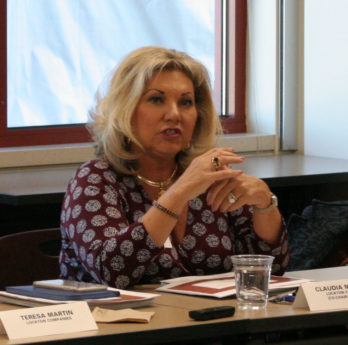
Claudia Mandato produced graphics showing the impact of effective diversity-inclusion efforts.
Those experiences formed a framework for a conversation that took up the better part of two hours. It started with Claudia Mandato of Lockton, who had a presentation of statistics about women in construction and the broader issues of diversity and inclusion. The figures therein reflected superior corporate performance among companies with diversified work forces. With that in mind, the deliberations were less about heavy machinery and materials costs than about the most important elements that go into any job site: the people behind it.
From that, Teresa Martin’s opening question went straight to the heart of differences between construction environments of today and those of 10, even five years ago, focusing on corporate cultures. For as much as construction has been remade by technology, fallout from the Great Recession, a crippling shortage of talent and myriad other factors, perhaps the greatest lasting impact will be left by the way cultures have changed, and continue to, as more women enter a domain long dominated by men.
Not that they have taken over, by any means: Even after sweeping changes that are bringing new associates and interns through corporate doors at nearly a 50/50 gender balance in many instances, women are still outnumbered 10-1 by men in construction, and by a considerable margin in its sister disciplines of engineering and design.
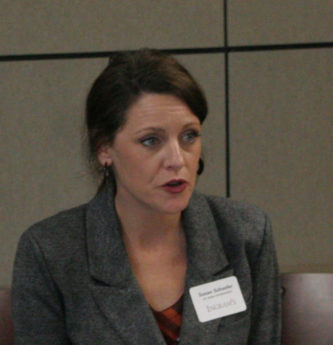
For Susan Schaefer, the lack of role models is especially pressing where expectant mothers are concerned.
But the values that have contributed to long-term success continue to drive growth in construction today.
For Kelsey Sundet of BRR Architecture, which operates on a national platform, the culture remains grounded in two main things: continuous improvement, and people. “We recruit for people and focus on continuous improvement up though the management team, so we feel strongly about the people who work for us and the people we’re trying to get to work for us,” she said.
At Monarch Build, where Courtney Kounkel must forgo the advantage of woman-business enterprise, just barely, by virtue of 50-50 ownership, “Our culture is really based on what the company was built on, building trust and an authentic environment, both internally and externally. I feel like in our industry, there are too many instances where that doesn’t happen.”
As with most successful businesses, the Sorella Group grounds its success in relationships, says owner Sheila Ohrenberg. That was true externally, at start-up, “when we were very small, then we took that internally. We’re team-based through every department and into the field.”
On the other end of the size spectrum is the massive JE Dunn Construction Co., the largest based in this market and a Top 20 contractor nationally. There, senior project manager Susan Schaefer says, the company works diligently to ensure a uniformity of culture across 20 offices nationally. And from what she’s seen in the past half decade or so, Schaefer says, “the culture change we’ve seen speaks loudly to inclusivity and trust.”
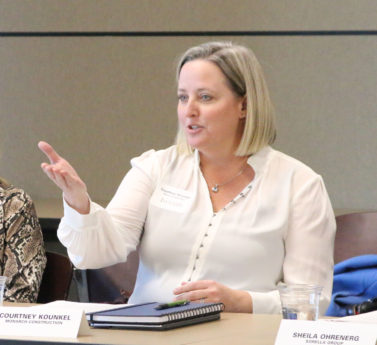
Not all workplace slights are intentional, Courtney Kounkel said, urging her colleagues to be more selective about when to be offended.
At A.L. Huber General Contractors, said CFO Mary Sue Keitel, “the culture is about family, as befits its ownership structure. “We are all about doing the right thing for people, clients, subs and employees,” she said.
Valerie Mussett, general manager and part owner of Design Mechanical, says the culture there was solid, but could be improved by fine-tuning some processes that had not necessarily taken a back seat during years of rapid growth. As the company embarks on those upgrades, she said, “the culture must stay the same. That is what made it successful. Yes, we want to get all of those jobs, yes, we want to hire and attract the best in the industry, but you still have to maintain the culture and standards that got you there.”
Other attendees deal with steel and concrete, but at the Heart of America chapter of Associated Builders and Contractors, “our culture is building people,” said Michele Roberts-Braun. “A substantial part of what we do is work-force development,” and sharing the story of construction with parents and with students looking for better opportunities for themselves.
Christy Turner—no relation to the namesake at Turner Construction, the nation’s largest builder—said the company where she’s a senior project manager had long been a leader in promoting women into senior roles, and many were now senior project managers.
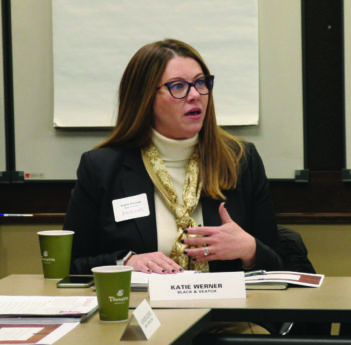
Katie Werner said an effective way to reach more diverse applicants is by reviewing the language of job descriptions to reveal hidden biases.
Citing corporate cultural values that prize integrity, relationships and performance, marketing director Sheri Johnson said McCownGordon Construction was the only one of more than half a dozen where she’s worked in which employees truly lived the values of this employee-owned firm. “Our goal is to enhance the construction journey for everyone involved, whether our associates, clients or partners,” she said.
Kathleen Glover, who came to water-infrastructure concern Garney Construction four years ago, has seen much change, as well, in 30 years. Most of that was with a smaller company that had an office of just seven people, she said, so she’s been pleased to see the emphasis on cultural focus at a national firm.
Out of seven core values at Black & Veatch, said Katie Werner, two of those—accountability and respect—are drivers of the diversity and inclusion efforts at the global design company. Then, too, she said, “we’re also 100 percent employee-owned, so we should have accountability to our shareholders, which are our employees. We want to do good for external clients, but I view people I work with as internal clients, to make sure we’re engaging with them.”
Support from the CEO’s office, said Meggan Krase, is particularly helpful for driving an embrace of inclusivity at Garney Construction. With a culture of entrepreneurship first postulated by founder Charles Garney, the corporate DNA is strong, but full inclusivity nonetheless requires vigilance. “We want to do it; I just think the way everyone in the company has been raised, there are still some who don’t know what they don’t know.”
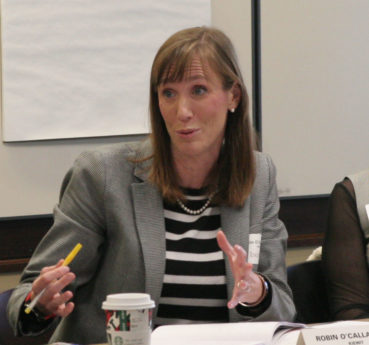
With women more represented in mid-management roles, said Robin O’Callaghan, the next step would be the executive and leadership ranks.
Lisa Garney, Charles’ daughter, now owns three WBE-certified companies of her own, including LMG Construction and G2, a concrete manufacturer. “I know what my father believed and his philosophies of altruism for yourself and your community, and excellence as a standard,” Garney said. “They’re still the same.”
At Kiewit, Katie Foster says her 10 years have witnessed a culture that is “intense, competitive, people-oriented and excellence-oriented.” Within that dynamic, she says, “we have seen a large shift, from very little to no women’s programming, to now, where we’re asking how much more can we put into women’s programming.”
SFS Architecture partner Marsha Hoff-man said her quarter-century of employment had been witness to fundamental shifts. It was, she said, “a majority of men for many years, and the culture was extremely different,” not at all like today’s assemblage with its more balanced representation of men and women.
Subcontractor Staco Electric, said Vanessa Linscott, has seen a doubling of growth in the four years since she assumed ownership of the 46-year-old company. A focus on family environment, including unlimited vacation time, helps reinforce the culture she wants to ensure.
Kim Robinett founded Trekk Design Group in her basement, where “diversity was in our DNA,” she said. Maintaining it, though, is a challenge at a time when talent is so hard to come by. “There are just not enough engineers to pull from that pipeline,” she said. On a broader cultural plane, she lamented the lack of TV shows that feature engineers, wishing those careers could be glamorized the way lawyers and doctors are.
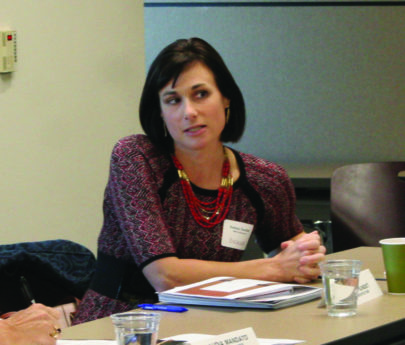
New mothers would benefit by simply having the confidence to
declare their needs to employers, said Kelsey Sundet.
Finding Talent
Teresa Martin pivoted the conversation to explore strategies that firms are using to crack the talent riddle. Women in construction were not spared the culling of the work force after the Great Recession, and while their numbers have rebounded since bottoming out in 2012, there are still fewer of them in the ranks—971,000 by the start of 2018—than at their 2007 peak of 1.12 million.
She also noted that, despite the significant improvement for women in the sector, “there is one thing to think about: this is not a very diverse group in terms of ethnic diversity,” as the table was populated by executive women who were all white. “So the challenge to all of us is not just women, but how we attract minorities, and how we get this to be a more diverse group.”
At McCownGordon, said Sheri Johnson, the focus on bringing in a more diverse employee base entails “going beyond the colleges in this area, going to some all-black universities and focusing on recruiting women and minorities.” The company also has a women-in-leadership program and has expanded its benefits suite to include perks that appeal to Millennials.
Katie Werner said that Black & Veatch had addressed some of the challenge by going back to its job descriptions. “We have ways to scan that wording, and that brings to mind that words are interpreted differently by gender and by race,” she said. Providing a job description that appeals to more diverse candidates can help. The firm also works with high schools and junior highs and youth groups like the Girl Scouts, reaching out with programs that promotes opportunities for construction careers.

Kimberly Robinett said the pipeline for new job candidates simply can’t produce enough engineers.
“We want to make sure women feel empowered so they don’t drop out in junior high, that they know they have as much right to sit in that room as the men do,” Werner said, and the benefits have been redesigned to focus on diverse family structures and reinforce a commitment to supporting those employees who need to miss time for family considerations.
Collaborations, as well, can be effective, said Vanessa Linscott. She said Staco Electric had set up a booth adjacent to Courtney Kounkel’s Monarch at a career fair for junior high students, who were surprised to find out that construction offered such varying disciplines. “This is how you can get involved and work together, not just as your own company, but as a partner and team to attract that young audience. I’m the mom of a middle-school daughter, and I don’t know where she’s going to end up, but I sure hope she thinks she can do it.”
The long-standing challenge, said Robin O’Callaghan, has been “a severe lack of role models for women. In grade school, an engineer was something I wanted to be, but the only engineer I knew of was MacGuyver.” That, she said, puts the onus on all in the room to become that role model. “Most of the women my age or above got into this profession because their dad was an engineer,” she said. “They were our role models.” Whether it’s with the Boys and Girls Clubs, the Boy Scouts or Girl Scouts or other youth groups that can be targeted for outreach, “there can never be too much of it,” she said.
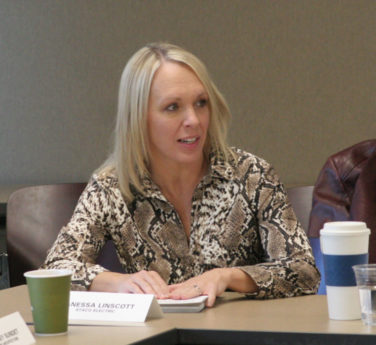
Construction companies might be able to make a bigger impact by aligning efforts at career fairs, said Vanessa Linscott.
It’s just as important, said Courtney Kounkel, to say yes when a call comes in asking for a presentation. “When an elementary school says they’re having a career fair, I say yes. It maybe will not benefit my company directly, but maybe it helps your companies. They need to see that’s an option for them,” she said.
There’s a deeper challenge here, she said. “I think we have lied to a whole generation, maybe several, telling them they can’t have a successful career if they don’t go to college. Look what that has done to our industry—we have a huge crisis in the trades. Nothing in the world happens without construction,” and technology won’t fill that gap. “Think of all the women who would be amazing on a job site. That’s a pool that has not even been tapped.”
That prompted Teresa Martin to reference “Ditch Diggers,” a poem by Eric Borden of Kissick Construction in Kansas City. A heavy-equipment operator there, Borden was moved to answer a less-than-flattering description of blue-collar workers that he’d overheard when other fathers were chatting at a birthday party.
Paired with video, it has become an Internet sensation among contractors with its core message: the white-collar world goes to work on roads and bridges built by blue-collar workers, who also erected the office towers that are home to banks, law firms and stock brokerages. Martin suggested that the executive firepower at the table could do the same to produce videos or other communications promoting women in construction.
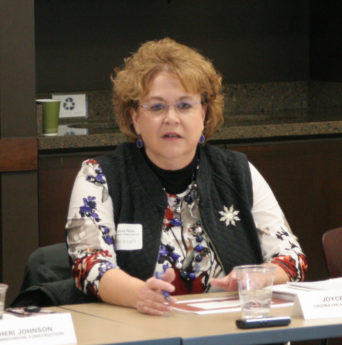
Joyce Farris recalled the days when she would be the only woman at a trade conference with hundreds of men.
“One of our biggest challenges is making it cool to be in construction,” said Susan Schaefer. She worked in Australia, where young adults are more open to skilled trades.
Luring young adults in will require more than just changing those young minds, said Meggan Krase: “We have to change the mind-set of parents and counselors,” she said. “They don’t know you can make a good living in construction.”
“It’s so disappointing to hear that it’s still happening with counselors,” said Marsha Hoffman. “My counselor in high school told me not to be an architect; he said I couldn’t make it—because he didn’t make it.”
“That mind-set is still there,” said Kathleen Glover. “I think in today’s world, that’s crazy.”
But it won’t change, said Lisa Garney, “until we get (the National Education Assn.) on board. They are not at a national level emphasizing construction as a career alternative. We have to come together on this.”
Another hurdle, said Katie Werner, is the debt load carried by those who do make it through a four-year school. “Being able to finance loans, that’s a real burden,” she said. “And it’s this American dream that can only end with a four-year college degree.” The area where Black & Veatch is struggling, she said, is with technicians. “We can’t get enough technicians in the U.S. to make it cost-competitive in a lot of spaces.”
Safety and Work Spaces

When addressing HR concerns that change in a fast-growth environment, said Valerie Mussett, it’s vital that the core factors that drove success remain intact.
Teresa Martin raised the matter of work environments, one that is a significant concern to women who want to be in the field. The assessment: Better, but room to improve.
“When I first started, to get a safety harness, the only thing they had was men’s large and extra large, which do not fit women,” said Katie Foster. “We had one harness, small, that we had to share, and they had to special-order that. But they’ve made great strides with personal-protection equipment, things like gloves that fit women’s smaller hands sizes.”
Job sites, said Christy Turner, “are still not very friendly for women. You have port-a-potties surrounded by men. It’s just not a great work environment.” That brought a sharp concurrence from Susan Schaefer regarding the half-pipe units. “I will not have one of those on my job site,” she flatly declared. “We need to say that is not OK.”
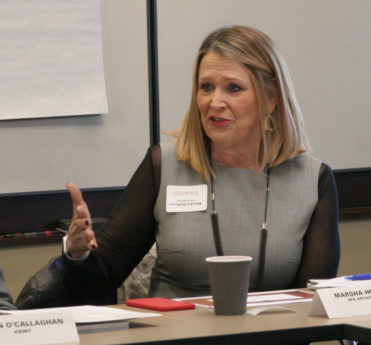
A high-school counselor dampened her dreams of being an architect, suggesting she go into a field more suitable for women, said Marsha Hoffman.
Neither is it OK, Courtney Kounkel suggested, to live on a razor’s edge when it comes to perceived slights.
“Twenty years or so ago, a man in his late 60s called me ‘Honey.’ Other women would say, doesn’t that drive you crazy? No, it doesn’t. It was not meant out of disrespect, it was his culture from another time. If a 25-year-old called me that, we’d have a chat. You have to choose when you let it offend you, and choose the people you can change or redirect, and those where it’s just, OK, move on, and don’t bring the negative energy. It often hurts women, and it sets us back more.”
Elsewhere, Susan Schaefer pointed to cultural shifts that were slowly increasing acceptance of the challenges faced by new mothers. Many of those who have children fall into the 10-to-15-year employee range, where significant numbers are dropping out of the field. Having been through pregnancy without role models, she’s happy to encourage and mentor expectant mothers who want to know how to balance the new demands on their time.
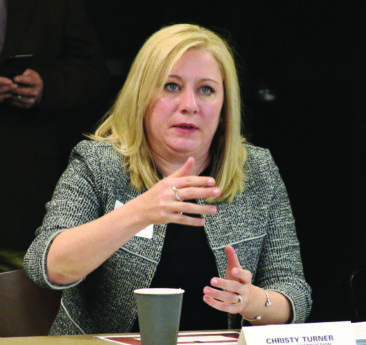
Christy Turner described conditions at job sites that were simply unfriendly to women.
“We focus on the 10-to-15-year out of school age,” said Kelsey Sundet. “I had three babies in three years, but came back every time, worked 40 hours, worked job sites, pumped on those sites. I was very open, about it.” But a lot of women lack that level of confidence, she said.
Increasingly, said Robin O’Callaghan, women fill mid-level management roles at Kiewit; next up are the executive ranks. “We don’t say we have to have x-number of women considered for every job, but we want to make sure we are at least considering the top woman for that position.”
Claudia Mandato turned the conversation toward benefits, and the way inclusivity is shaping those. Maternity leave has given way to parental leave accessible to men as well as women (for natural birth and adoption), paid time off is increasing at best-practices companies (as much as 10 weeks at some) and HR language is being fine-tuned to embrace the concerns of families of various structures.
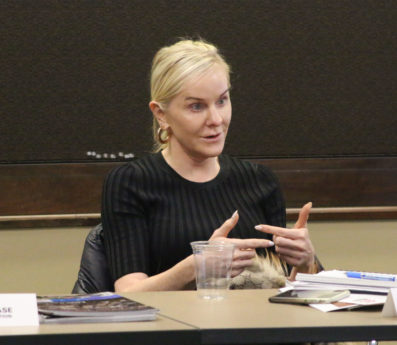
Unless construction works with educators to emphasize trades careers, said Lisa Garney, the college-first impulses of high school counselors won’t change.
At Black & Veatch, such changes are “a huge step in the right direction,” said Katie Werner. “I hate to say this, but our paternity leave up until now was one day. We were honestly losing Millennials because men are asking that question. It’s silly to say go see the birth and get right back to the office.”
Those factors and more are signposts along the way to a new construction sector. As Katie Foster summarized: “I think the generation below us is very exciting. This sector once was very male-dominated, but now it’s transitioning.”
“As a society, too often we see an issue, gain some momentum, then let up,” said Kim Robinett. “It’s important for all of us to continue to be voices” for that change.
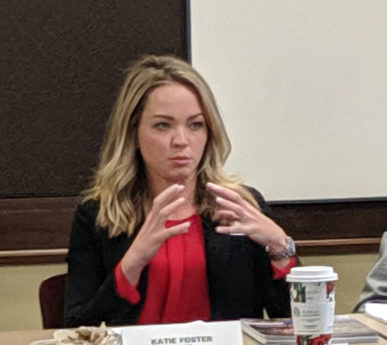
Katie Foster described how the lack of personal-protection equipment available to women on job sites can discourage women from doing site work.